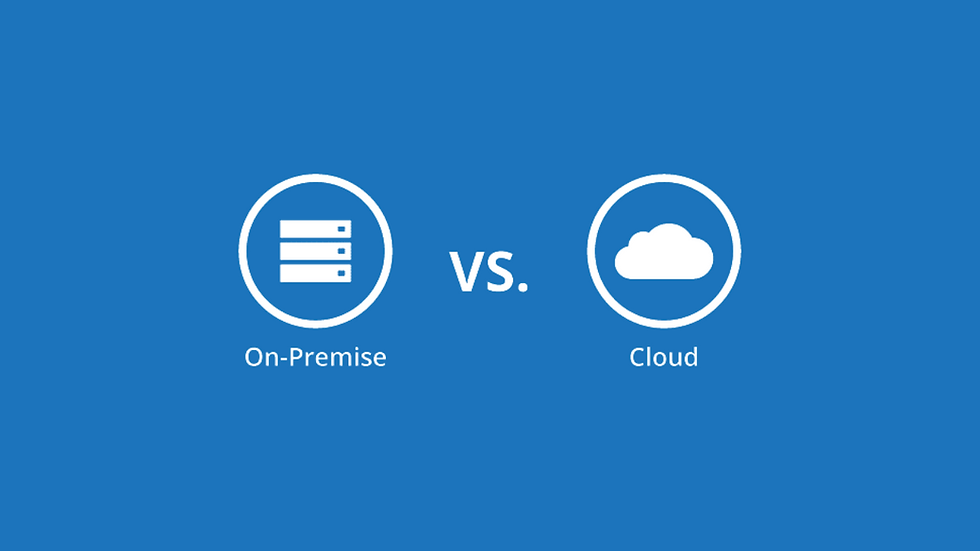Microsoft Azure vs. On-Prem: What’s best for your firm?
- emilyangold
- Oct 13, 2022
- 4 min read
Updated: Nov 2, 2022
With so many companies moving over to the cloud, it’s obvious that a lot of them are seeing the benefits of Azure. However, is it right for your law firm?
You understandably may still be hesitant to make a move over. After all, shifting to a cloud-based system will inevitably be a massive change for your business — which means that you need to make sure that moving forward to Microsoft Azure is the right choice for you.
We believe that anyone should be able to make the move over. That’s why in this article, we’ll go over the benefits and drawbacks of both on-premises (on-prem) and cloud-based (Azure) solutions.
We’ll also explore why Azure is the superior option in the modern world, and how you can get started today!
On-Prem Solutions
An on-premises IT solution is essentially when all of your applications, data, and systems are contained within your own internal computer servers.
This infrastructure is a relic of a pre-cloud era of technology, where systems would be stored on physical server hardware within an organisation.
There are certain reasons for wanting to keep your systems in-house. However, most of these reasons are incredibly irrelevant to the day-to-day running of an organisation. Realistically, a cloud-based solution is enough for most organisations’ needs.
Benefits
Control: On-prem solutions allow firms to retain all their data and are in complete control of what happens to it, including private client data. In some highly regulated industries, organisations such as legal, they are more likely to go on-prem for this exact reason. With this being said, this control is only a benefit if the system administrator has set up appropriate security controls.
Reliability: If your firm experiences internet downtime, this will render any cloud-based systems inaccessible, and potentially could disrupt workflow and cause important data to become corrupted. However, this is an incredibly rare occurrence — the benefits of a cloud-based system often outweigh this slight flaw.
Drawbacks
Costs: Physical servers are expensive. You have to account for the running costs, the costs of the hardware, the cost of a server maintenance team, and possible installation costs. All of this means that you’re going to be losing money for minimal upside. For lots of smaller firms, spending money like this can often be unrealistic or even be a death knell for your finances.
Scalability: Whenever your organisation experiences growth, your servers will need to expand with it. Physical servers are both difficult and expensive to scale, meaning that any growth will just be a pain and hassle for your maintenance team.
Reliability: Whilst having obvious reliability benefits, there are also many downsides to the reliability of in-house servers. If your servers experience any hardware failure or power outages, there’s no way for anyone to be able to access your systems.
Microsoft Azure
Microsoft Azure is a public cloud hosting system - in which your systems and applications are hosted online.
The multitude of advantages of the cloud means that many businesses are looking toward Azure as the future of cloud computing.
Benefits
Costs: Rather than having to pay for server hardware and maintenance, you just pay a fee to Microsoft and let them handle that side. This can dramatically reduce IT costs, as remotely maintaining your Azure means fewer on-hand IT workers will be needed than when using physical server hardware.
Convenience: Microsoft Azure is incredibly convenient for business owners and employees alike. With direct integration with Microsoft 365, Azure makes working from anywhere — whether it be in the office or remote — much easier and more effective.
Reliability: Rather than having to rely on hardware maintenance, Azure is run by Microsoft’s expert tech team. This means that any issues you encounter can be fixed with a simple support call and that you never have to worry about hardware malfunction.
Modernisation: Cloud computing is the future. Unless truly needed, sticking with on-prem solutions means that you’ll be left behind as the industry moves into the future. Cloud-based solutions are often regularly updated to be compatible with new features and integrations, which is much easier than needing to upgrade your in-house systems each time.
Drawbacks
Externality: Organisations may refuse to opt for a cloud-based solution as their data is sensitive and may be wary of the security risks associated with transporting data to the cloud. This added security risk, however, is not really a risk for most organisations — a well-set-up security system can often eliminate these risks.
Which is Right for your Business?
On-prem solutions are often excessive for most businesses, and mainly only benefit organisations that operate in the government sector or medical sector, or other similar fields. And, even then — on-prem solutions are a precaution for a problem that is incredibly rare. And so, there’s no real reason not to make a move to the future of computing today!
Cloud computing has many advantages over traditional servers and often runs at a much lower operating cost. This is the crucial advantage of Azure over on-prem solutions and is the reason why many companies are making a move over to the cloud.
Do you wish to focus more on the strategic goals and avoid dedicating valuable resources to manage your systems and applications? We can help with our comprehensive Azure hosting and managed service package.
Get in touch with us to get started today!





Comments